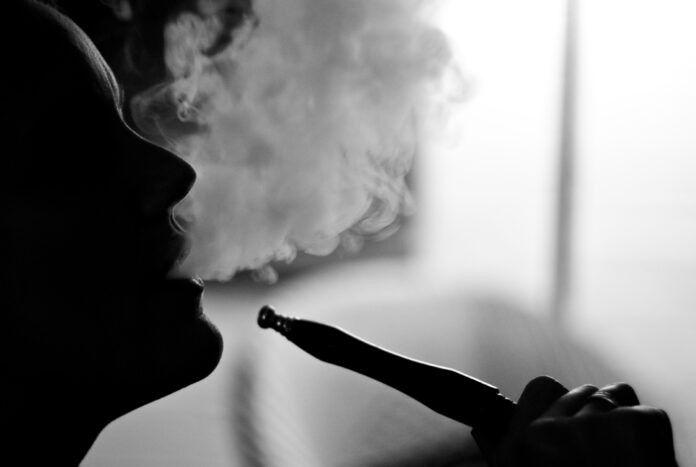Dhairya Bhatia faced down identity crisis by finding a deity in curls of smoke.

Out of his mouth came a steady stream of smoke, as cool as a cloud of breath in the dead of winter. The gas made a visible arc from one orifice to the other, out in the open air but never truly free of his grasp. As Dhairya Bhatia, a 21-year old senior and political science major at Rutgers University, played with his hookah vapor, he was surrounded by loops of burning incense that slowly swirled all around him.
The flowing, circular nature of the smoke connected him to his sense of spirituality. It reminded him of home, and of the cyclical structure of Hinduism, the religion in which he was raised. He could feel his God in the wisps and fog, and although at times he felt way too distant from The Being, smoking made him feel “at one” with something greater than himself. At least for a little while.
“I think my relationship with God is complicated. It’s sure as hell not Facebook official,” said Bhatia. “Being a first generation American, there’s a boatload of conflicts going on with my identity.”
Bhatia lives on an alternate plane, with a population of one. He describes this place as “halfway between America and India” — a concept he takes from the Pulitzer-prizewinning author Jhumpa Lahiri, who was born in London to Bengali parents, and raised in America. He never felt at home with any of the identities and labels — Indian, American, Hindu, millennial — handed to him at birth. His development straddles a number of boundaries and about 8,000 miles: he was literally conceived in Kanpur, India, and born nine months later in Queens, USA.
Like many first-generation Americans, Bhatia’s identity crisis encapsulates all parts of his life, but reaches its pinnacle in his heritage and religion.
“I’m not even sure if I would consider myself to be a Hindu. By most orthodox means, I’m probably not categorized as one, but I identify as one,” he confessed. “When my family moved here, my mother wanted us to assimilate as quickly as possible. As a result, I grew up with TV as my religion, more than Hindu religious or spiritual scripture.”
“I’ve known Dhairya for a few years, and I have always been amazed by his ability to find spirituality in everything he does,” commented Megan McKay, one of Bhatia’s best friends. “He’s never preachy about it, but he’s always able to spew these connections between his Hindu background and everyday activities.”
Bhatia’s household was not free of Hindu traditions. In fact, his mother was an active practitioner of the religion, and made sure to involve him too.
“Every morning my mother would be sitting in the office reading from her copy of the Mahabharata, singing prayers, doing pooja [ritual prayers to the deities, or the deceased],” he reminisced. “She tells me after I shower to come downstairs to pray with her and eat “Prasad” [offers that are blessed]. And I can’t use my left hand, even though I’m lefty, I have to use my right hand.”
His involvement with his mom’s practice eventually led to him to follow suit. He prayed every day during his middle school years, asking his favorite god, Krishna, to protect those around him.
Still, he hit a few bumps on the road towards religious righteousness. He never learned enough Hindi to read prayer. Nor did he get the correct way to pray down. Then, other facets of life began to get in the way of his practice. He stopped praying for others, and starting praying more sporadically, and almost entirely for himself: to win a race at his track meet, to get the prettiest girl, to get the best grade.
“I think I lost myself in high school, with this “me first” mentality,” he said. “And consequently I lost connection to my religion.”
In college, he found that he didn’t need to go by the book. Ironically, never truly delving into the customary way of doing things brought him closer to his God. Being so far from home allowed him to rediscover what it means to have to pray to protect the ones you love. It also let him see a deity in his curls of smoke, and find solace in his burning sage.
Hookah and incense aren’t the only ways Bhatia connects with his identity. He says that his father, although not particularly spiritual, had once told him that, when praying, he should focus on his “third eye.” Bhatia never forgot that little tip, and rediscovered it in 2013, in underground rap.
“He told it to me first. It just came back up in the form of hip hop,” he elaborated. “My spirituality and faith pop up in my life like that. Not in the way, like, an orthodox religious awakening, but in the little symbolic ways.”
Professor of religion and Rutgers Scholar Diane Shane Fruchtman affirms that this tension between worlds is normal, and that “updating” a religion to meet one’s own daily reality is nothing new.
“By virtue of being practiced within a culture, every tradition has to interact with that culture and is thus, in some way, being shaped by it … even as language changes and technology shifts, religious traditions change to incorporate, resist, or respond to those changes,” she said.
Bhatia’s faith was home-schooled to him: not by religious texts or praxis, but by college living. His new home became urban New Jersey, and Brooklyn rapper Joey Bada$$, instead of scripture and smoke, became one of this godly offerings,
After failing to unselfishly follow his faith during high school, university was the ultimate reminder of what he felt was most important about His Hinduism: peace and love. Praying on his own terms opened him up to the light, and put him back into a position to spread these two critical ideologies.
“We can’t bring people around us down,” he said. “We have to better ourselves, and those around us. And although I can’t tell you where in Hindu scripture that’s said, I’d be willing to bet you a million dollars it’s there.”


